Unit 6 6 Space and beyond Understanding ideas 课件(共31张PPT) 2024-2025学年高二英语外研版(2019)选择性必修4
文档属性
| 名称 | Unit 6 6 Space and beyond Understanding ideas 课件(共31张PPT) 2024-2025学年高二英语外研版(2019)选择性必修4 | 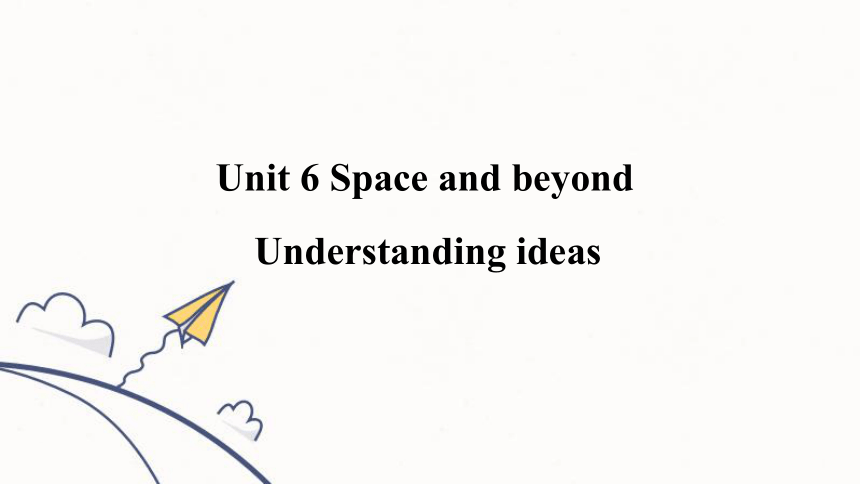 | |
| 格式 | pptx | ||
| 文件大小 | 4.5MB | ||
| 资源类型 | 教案 | ||
| 版本资源 | 外研版(2019) | ||
| 科目 | 英语 | ||
| 更新时间 | 2025-04-22 17:32:29 | ||
图片预览

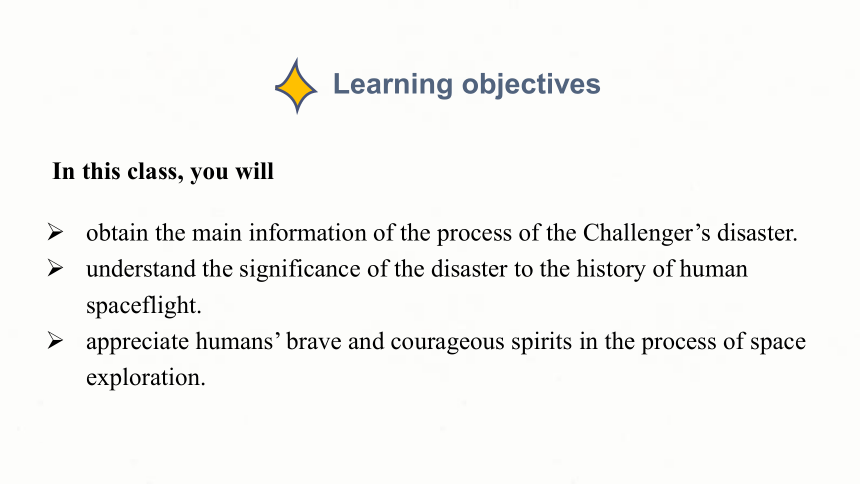
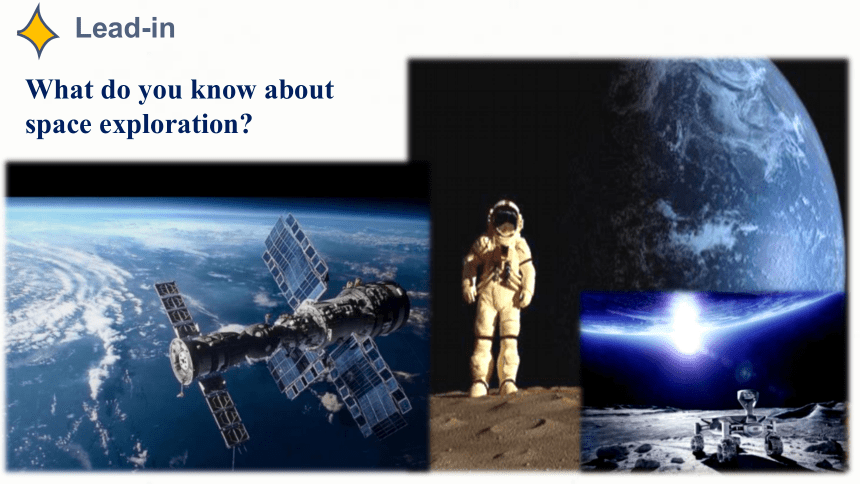
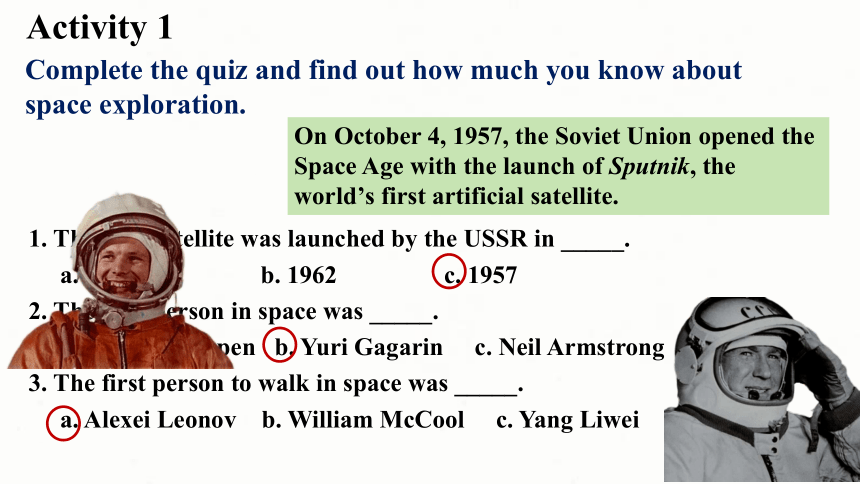
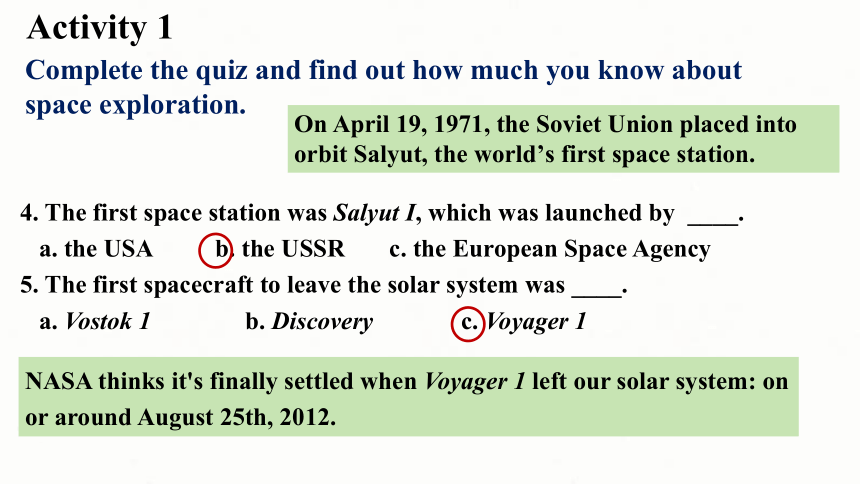
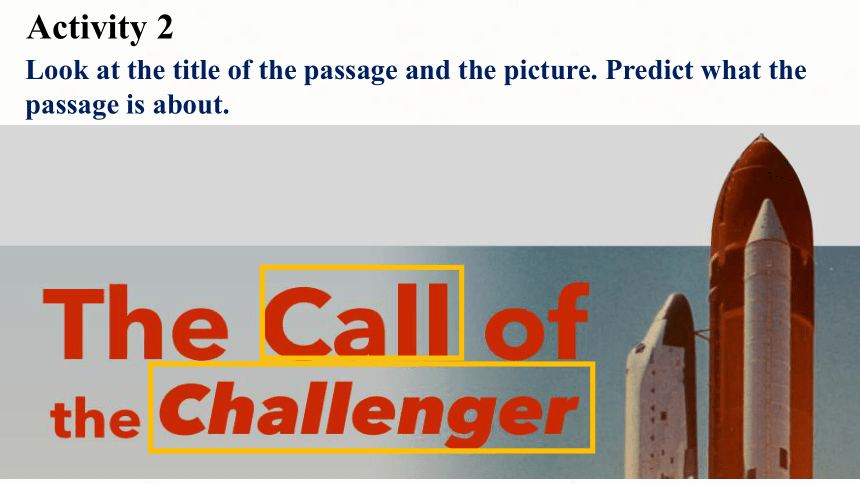
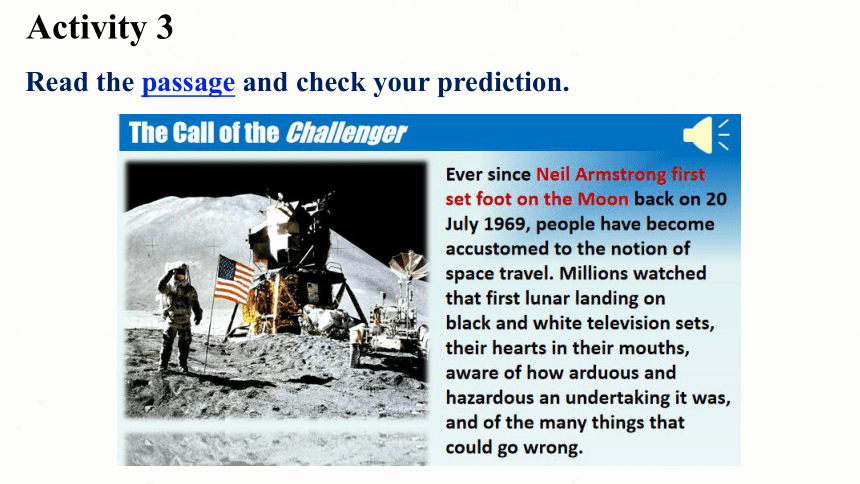
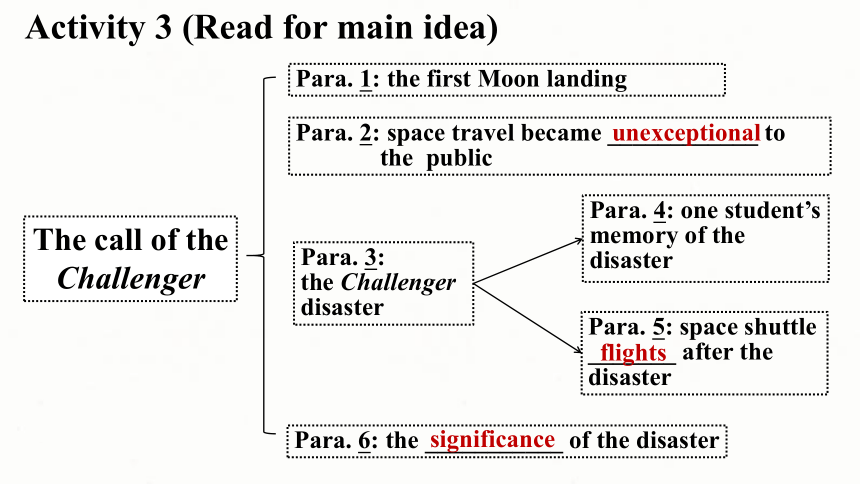

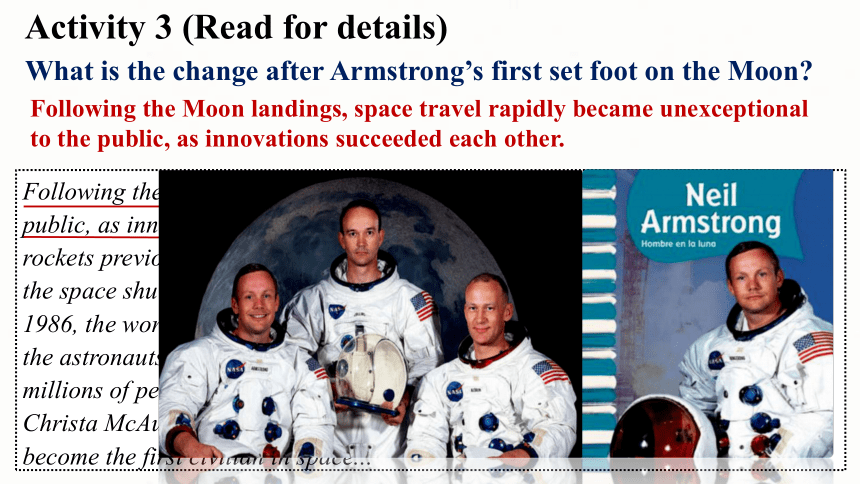


文档简介
(共31张PPT)
Understanding ideas
Unit 6 Space and beyond
In this class, you will
obtain the main information of the process of the Challenger’s disaster.
understand the significance of the disaster to the history of human spaceflight.
appreciate humans’ brave and courageous spirits in the process of space exploration.
Learning objectives
What do you know about space exploration
Lead-in
Activity 1
Complete the quiz and find out how much you know about space exploration.
1. The first satellite was launched by the USSR in _____.
a. 1945 b. 1962 c. 1957
2. The first person in space was _____.
a. Robert Crippen b. Yuri Gagarin c. Neil Armstrong
3. The first person to walk in space was _____.
a. Alexei Leonov b. William McCool c. Yang Liwei
On October 4, 1957, the Soviet Union opened the Space Age with the launch of Sputnik, the world’s first artificial satellite.
Complete the quiz and find out how much you know about space exploration.
4. The first space station was Salyut I, which was launched by ____.
a. the USA b. the USSR c. the European Space Agency
5. The first spacecraft to leave the solar system was ____.
a. Vostok 1 b. Discovery c. Voyager 1
On April 19, 1971, the Soviet Union placed into orbit Salyut, the world’s first space station.
NASA thinks it's finally settled when Voyager 1 left our solar system: on or around August 25th, 2012.
Activity 1
Look at the title of the passage and the picture. Predict what the passage is about.
Activity 2
Read the passage and check your prediction.
Activity 3
The call of the Challenger
Para. 1: the first Moon landing
Para. 2: space travel became ____________ to the public
Para. 3:
the Challenger disaster
Para. 4: one student’s memory of the disaster
Para. 6: the ___________ of the disaster
unexceptional
significance
Para. 5: space shuttle
_______ after the disaster
flights
Activity 3 (Read for main idea)
Choose the ideas mentioned in the passage and find the evidence.
1 People thought space travel was no longer dangerous.
2 Christa would have inspired lots of people if she hadn’t lost her life on board the Challenger.
3 People were determined to continue with the space programme after the disaster.
4 The disaster proved we should use robots to explore space instead of people.
5 The shuttle was not reliable and should not have been used.
√
√
√
①
②
③
②
Activity 3 (Read and choose)
Following the Moon landings, space travel rapidly became unexceptional to the public, as innovations succeeded each other. By the early 1980s, the great rockets previously used in the American space programme had been replaced by the space shuttle. When the Challenger space shuttle took off on 28 January 1986, the world seemed to have lost its wonder at the Amazing achievements of the astronauts involved. But this was going to be no ordinary excursion, and millions of people tuned in to witness the take-off on TV. It was special because Christa McAuliffe aged 37, an ordinary teacher and mother, was about to become the first civilian in space...
Following the Moon landings, space travel rapidly became unexceptional to the public, as innovations succeeded each other.
What is the change after Armstrong’s first set foot on the Moon
Activity 3 (Read for details)
Activity 3 (Read for details)
When the Challenger space shuttle took off on 28 January 1986, the world seemed to have lost its wonder at the Amazing achievements of the astronauts involved. But this was going to be no ordinary excursion, and millions of people tuned in to witness the take-off on TV. It was special because Christa McAuliffe aged 37, an ordinary teacher and mother, was about to become the first civilian in space.
Tragically, she never returned to her classroom as the shuttle exploded just over a minute after taking off in Florida, and all seven astronauts on board were killed.
What about the time, place, and crew of the Challenger
Time :
Place :
Crew:
28 January 1986
seven astronauts, including a teacher
Space Centre in Florida, USA
When the Challenger space shuttle took off on 28 January 1986, the world seemed to have lost its wonder at the Amazing achievements of the astronauts involved. But this was going to be no ordinary excursion, and millions of people tuned in to witness the take-off on TV. It was special because Christa McAuliffe aged 37, an ordinary teacher and mother, was about to become the first civilian in space.
What was special about the Challenger launch
It was special because Christa McAuliffe aged 37, an ordinary teacher and mother, was about to become the first civilian in space.
Activity 3 (Read for details)
It was special because Christa McAuliffe aged 37, an ordinary teacher and mother, was about to become the first civilian in space. She planned to give two 15-minute lessons from orbit: the first to demonstrate the controls of the spacecraft and explain how gravity worked, and the second to describe the objectives of the Challenger programme. Christa hoped to communicate a sense of excitement and rekindle interest in the space programme. With the eyes of students across the nation upon her, she might have inspired an entirely new generation of astronauts and space scientists.
What was the teacher’s mission on board the Challenger
She planned to give two 15-minute lessons from orbit: the first to demonstrate the controls of the spacecraft and explain how gravity worked, and the second to describe the objectives of the Challenger programme.
Activity 3 (Read for details)
Tragically, she never returned to her classroom as the shuttle exploded just over a minute after taking off in Florida, and all seven astronauts on board were killed. The world went into shock, most people having assumed that this space flight would be no more dangerous than travelling in an aeroplane. How wrong they had been! Instantaneously, excitement and optimism turned into terror and failure. It was the most disastrous space accident ever, and it cast a shadow on people’s hearts.
What were people’s feelings before and after the Challenger disaster
Before the Challenger disaster, people felt optimistic and were very excited to watch the take-off on TV. They became shocked and scared after the disaster.
Activity 3 (Read for details)
Following the shock of the Challenger disaster, space shuttle flights were suspended for nearly three years while the cause of the disaster was investigated, and some of the shuttle’s components were redesigned. But there was never any doubt that manned flights would continue, and on 29 September 1988, the space shuttle programme resumed with the successful launch of Discovery.
What was done in the three years following the disaster
Space shuttle flights were suspended for nearly three years while the cause of the disaster was investigated, and some of the shuttle’s components were redesigned.
Activity 3 (Read for details)
Following the shock of the Challenger disaster, space shuttle flights were suspended for nearly three years while the cause of the disaster was investigated, and some of the shuttle’s components were redesigned. But there was never any doubt that manned flights would continue, and on 29 September 1988, the space shuttle programme resumed with the successful launch of Discovery.
Which shuttle followed the Challenger, and when was it launched
Discovery followed the Challenger, and was launched on 29 September 1988.
Activity 3 (Read for details)
Try to summarize the text after reading for details.
With Neil Armstrong’s successful landing on the Moon on 20 July 1969, people have became accustomed to the notion of space travel. However, the disaster of the Challenger on 28 January 1986, cast a shadow on people’s hearts. Dangerous as it is, people never stop the pace of space exploration, and on 29 September 1988 witnessed the successful launch of Discovery. The heroic deeds of the astronauts inspire us to go on with the exploration.
Activity 4 (Read and summarize)
Talk about what you can learn from the Challenger disaster.
Activity 5 (Read and discuss)
Why do you think people continue to explore space despite the risks
1. Do you know of any other disasters that have occurred while exploring space
The Columbia disaster occurred on Feb. 1, 2003, when NASA’s space shuttle Columbia broke up as it returned to the Earth, killing the seven astronauts on board. NASA suspended space shuttle flights for more than two years as it investigated the cause of the Columbia disaster. The Columbia mission was the second space shuttle disaster after the Challenger. The disaster directly led to the retirement of the space shuttle fleet in 2011.
Activity 6 (Think and share)
2. Would you like to go into space Why
I would love to go into space because I have loved reading and researching space. I would love to see some spiral galaxies while I'm in space.”
3. What language in the passage could you use to describe other events in space exploration
Activity 6 (Think and share)
Language points
课文回顾:
On 20 July 1969, as Neil Armstrong set foot ___ the Moon, millions watched with their hearts in their _______ (mouth). In spite of the difficult technical conditions, all three astronauts of the Apollo 11 mission _________ (return) to the earth safe and sound. __________ (Follow) the Moon landings, people became __________ (accustom) to the notion of space travel. The world seemed to have lost its wonder at the amazing achievements of the astronauts involved. Christa McAuliffe, an ordinary teacher, was about to become the first civilian in space. ___________(unlucky), a minute after the shuttle took _____, it exploded, killing all seven astronauts on board.
The tragedy cast a shadow on people’s hearts. Space shuttle flights ______________(suspend) for nearly three years following the disaster. Meanwhile, scientists made some _____________ (improve), and on 29 September 1988, Discovery was launched successfully.
Over 30 years have passed since the loss of Challenger, and the heroic deeds of the astronauts inspire us to go on with the ________ (great) journey of exploration and discovery.
Following
accustomed
on
mouths
returned
Unluckily
off
were suspended
improvements
greatest
Fill in the blanks according to the passage.
1. Ever since Neil Armstrong first set foot on the Moon back on 20 July 1969, people have become accustomed to the notion of space travel.
句意:自从1969年7月20日尼尔 阿姆斯特朗踏上月球以来,人们已经习惯了太空旅行的概念。
The shepherd was a person who was accustomed to having eight hours’ sleep a night.
这个牧羊人是一个习惯每晚睡八个小时的人。
I must get accustomed to the new job as soon as possible.
我必须尽快地适应新的工作。
You have to get used to bacon and eggs with a few slices of toast for breakfast over there.
你得习惯那边早餐吃培根和鸡蛋,再配上几片吐司。
be/ become/ grow/ get accustomed to (doing) sth. 习惯于(做)某事
get/ be used to (doing) sth. 习惯于……
be used to do sth. 被用来做某事
used to do sth. 过去常常做某事
I was accustomed to ______(be) the only child at a table full of adults.
She had not yet become accustomed ____ the fact that
she was a rich woman.
She used to _____(live) with her parents, but now she is used to _______(live) with her classmates at school.
【语法填空】
being
living
live
【语块积累】
to
2. It was the most disastrous space accident ever, and it cast a shadow on people’s hearts.
句意:这是有史以来最灾难性的太空事故,它在人们的心中留下了阴影。
A researcher has now cast/throw light on the mystery of how the pyramids were built.
一位研究人员现在已经揭开了金字塔的建造之谜。
② The children were having fun, chasing each other’s shadows.
孩子们追逐着彼此的影子,玩得很开心。
The new leader wants to escape from the shadow of his predecessor.
新任领导想要摆脱前任的影响。
The accident cast a shadow ____ the safety of China’s fast expanding subway network.
小时候树在湖上投下了奇怪的影子给他的心理蒙上阴影。
As a child, the strange _________ that trees throw on the lake ________________ his mind.
cast a shadow on 给……蒙上阴影
cast/ throw light on 使(某事)显得非常清楚;阐明
shade n. 阴凉处,背阴处。指树荫等遮挡阳光的阴凉之地,无一定的轮廓。
shadow n. 影子,阴影。指人或物在光照下形成的影像,有明显的轮廓。
【语法填空】
on
【易混辨析】shade/shadow
shadows
cast a shadow on
3. It has now been over 30 years since the loss of Challenger and although the lives of its crew were cut tragically short...
句意:自从“挑战者”号失事至今已经30多年了,尽管机组人员的生命被悲惨地缩短了……
The officers and crew prepared to abandon the vessel in an orderly fashion.
军官和船员有条不紊地准备弃船。
主谓一致问题:
audience/class/family/team/group/crowd/crew
作主语(强调整体)+单数谓语动词+其他
audience/class/family/team/group/crowd/crew
作主语(强调个体)+复数谓语动词+其他
The class ______(be) to play different parts in the play.
His audience mainly _________(consist) of football lovers.
The crew ______(be) of different nationalities and have no common language.
【语法填空】
are
consists
are
4. Millions watched that first lunar landing on black and white television sets, their hearts in their mouths, aware of
how arduous and hazardous an undertaking it was, and of many things that could go wrong.
句意:数百万人通过黑白电视机观看了第一次月球登陆,他们心惊胆战,意识到这是一项多么艰巨和危险的任务,也意识到了许多可能出错的事情。
that引导定语从句
how引导宾语从句
形容词短语作状语
句子结构分析
5. Guided by a computer that was much less powerful than the ones used by today’s average school students, all three astronauts of the Apollo 11 mission made it safely back to Earth.
句意:在一台比现在普通学生使用的电脑功能要弱得多的电脑的引导下,阿波罗11号任务的三名宇航员安全返回了地球。
过去分词短语作状语
过去分词短语作定语
that引导定语从句
句子结构分析
Understanding ideas
Unit 6 Space and beyond
In this class, you will
obtain the main information of the process of the Challenger’s disaster.
understand the significance of the disaster to the history of human spaceflight.
appreciate humans’ brave and courageous spirits in the process of space exploration.
Learning objectives
What do you know about space exploration
Lead-in
Activity 1
Complete the quiz and find out how much you know about space exploration.
1. The first satellite was launched by the USSR in _____.
a. 1945 b. 1962 c. 1957
2. The first person in space was _____.
a. Robert Crippen b. Yuri Gagarin c. Neil Armstrong
3. The first person to walk in space was _____.
a. Alexei Leonov b. William McCool c. Yang Liwei
On October 4, 1957, the Soviet Union opened the Space Age with the launch of Sputnik, the world’s first artificial satellite.
Complete the quiz and find out how much you know about space exploration.
4. The first space station was Salyut I, which was launched by ____.
a. the USA b. the USSR c. the European Space Agency
5. The first spacecraft to leave the solar system was ____.
a. Vostok 1 b. Discovery c. Voyager 1
On April 19, 1971, the Soviet Union placed into orbit Salyut, the world’s first space station.
NASA thinks it's finally settled when Voyager 1 left our solar system: on or around August 25th, 2012.
Activity 1
Look at the title of the passage and the picture. Predict what the passage is about.
Activity 2
Read the passage and check your prediction.
Activity 3
The call of the Challenger
Para. 1: the first Moon landing
Para. 2: space travel became ____________ to the public
Para. 3:
the Challenger disaster
Para. 4: one student’s memory of the disaster
Para. 6: the ___________ of the disaster
unexceptional
significance
Para. 5: space shuttle
_______ after the disaster
flights
Activity 3 (Read for main idea)
Choose the ideas mentioned in the passage and find the evidence.
1 People thought space travel was no longer dangerous.
2 Christa would have inspired lots of people if she hadn’t lost her life on board the Challenger.
3 People were determined to continue with the space programme after the disaster.
4 The disaster proved we should use robots to explore space instead of people.
5 The shuttle was not reliable and should not have been used.
√
√
√
①
②
③
②
Activity 3 (Read and choose)
Following the Moon landings, space travel rapidly became unexceptional to the public, as innovations succeeded each other. By the early 1980s, the great rockets previously used in the American space programme had been replaced by the space shuttle. When the Challenger space shuttle took off on 28 January 1986, the world seemed to have lost its wonder at the Amazing achievements of the astronauts involved. But this was going to be no ordinary excursion, and millions of people tuned in to witness the take-off on TV. It was special because Christa McAuliffe aged 37, an ordinary teacher and mother, was about to become the first civilian in space...
Following the Moon landings, space travel rapidly became unexceptional to the public, as innovations succeeded each other.
What is the change after Armstrong’s first set foot on the Moon
Activity 3 (Read for details)
Activity 3 (Read for details)
When the Challenger space shuttle took off on 28 January 1986, the world seemed to have lost its wonder at the Amazing achievements of the astronauts involved. But this was going to be no ordinary excursion, and millions of people tuned in to witness the take-off on TV. It was special because Christa McAuliffe aged 37, an ordinary teacher and mother, was about to become the first civilian in space.
Tragically, she never returned to her classroom as the shuttle exploded just over a minute after taking off in Florida, and all seven astronauts on board were killed.
What about the time, place, and crew of the Challenger
Time :
Place :
Crew:
28 January 1986
seven astronauts, including a teacher
Space Centre in Florida, USA
When the Challenger space shuttle took off on 28 January 1986, the world seemed to have lost its wonder at the Amazing achievements of the astronauts involved. But this was going to be no ordinary excursion, and millions of people tuned in to witness the take-off on TV. It was special because Christa McAuliffe aged 37, an ordinary teacher and mother, was about to become the first civilian in space.
What was special about the Challenger launch
It was special because Christa McAuliffe aged 37, an ordinary teacher and mother, was about to become the first civilian in space.
Activity 3 (Read for details)
It was special because Christa McAuliffe aged 37, an ordinary teacher and mother, was about to become the first civilian in space. She planned to give two 15-minute lessons from orbit: the first to demonstrate the controls of the spacecraft and explain how gravity worked, and the second to describe the objectives of the Challenger programme. Christa hoped to communicate a sense of excitement and rekindle interest in the space programme. With the eyes of students across the nation upon her, she might have inspired an entirely new generation of astronauts and space scientists.
What was the teacher’s mission on board the Challenger
She planned to give two 15-minute lessons from orbit: the first to demonstrate the controls of the spacecraft and explain how gravity worked, and the second to describe the objectives of the Challenger programme.
Activity 3 (Read for details)
Tragically, she never returned to her classroom as the shuttle exploded just over a minute after taking off in Florida, and all seven astronauts on board were killed. The world went into shock, most people having assumed that this space flight would be no more dangerous than travelling in an aeroplane. How wrong they had been! Instantaneously, excitement and optimism turned into terror and failure. It was the most disastrous space accident ever, and it cast a shadow on people’s hearts.
What were people’s feelings before and after the Challenger disaster
Before the Challenger disaster, people felt optimistic and were very excited to watch the take-off on TV. They became shocked and scared after the disaster.
Activity 3 (Read for details)
Following the shock of the Challenger disaster, space shuttle flights were suspended for nearly three years while the cause of the disaster was investigated, and some of the shuttle’s components were redesigned. But there was never any doubt that manned flights would continue, and on 29 September 1988, the space shuttle programme resumed with the successful launch of Discovery.
What was done in the three years following the disaster
Space shuttle flights were suspended for nearly three years while the cause of the disaster was investigated, and some of the shuttle’s components were redesigned.
Activity 3 (Read for details)
Following the shock of the Challenger disaster, space shuttle flights were suspended for nearly three years while the cause of the disaster was investigated, and some of the shuttle’s components were redesigned. But there was never any doubt that manned flights would continue, and on 29 September 1988, the space shuttle programme resumed with the successful launch of Discovery.
Which shuttle followed the Challenger, and when was it launched
Discovery followed the Challenger, and was launched on 29 September 1988.
Activity 3 (Read for details)
Try to summarize the text after reading for details.
With Neil Armstrong’s successful landing on the Moon on 20 July 1969, people have became accustomed to the notion of space travel. However, the disaster of the Challenger on 28 January 1986, cast a shadow on people’s hearts. Dangerous as it is, people never stop the pace of space exploration, and on 29 September 1988 witnessed the successful launch of Discovery. The heroic deeds of the astronauts inspire us to go on with the exploration.
Activity 4 (Read and summarize)
Talk about what you can learn from the Challenger disaster.
Activity 5 (Read and discuss)
Why do you think people continue to explore space despite the risks
1. Do you know of any other disasters that have occurred while exploring space
The Columbia disaster occurred on Feb. 1, 2003, when NASA’s space shuttle Columbia broke up as it returned to the Earth, killing the seven astronauts on board. NASA suspended space shuttle flights for more than two years as it investigated the cause of the Columbia disaster. The Columbia mission was the second space shuttle disaster after the Challenger. The disaster directly led to the retirement of the space shuttle fleet in 2011.
Activity 6 (Think and share)
2. Would you like to go into space Why
I would love to go into space because I have loved reading and researching space. I would love to see some spiral galaxies while I'm in space.”
3. What language in the passage could you use to describe other events in space exploration
Activity 6 (Think and share)
Language points
课文回顾:
On 20 July 1969, as Neil Armstrong set foot ___ the Moon, millions watched with their hearts in their _______ (mouth). In spite of the difficult technical conditions, all three astronauts of the Apollo 11 mission _________ (return) to the earth safe and sound. __________ (Follow) the Moon landings, people became __________ (accustom) to the notion of space travel. The world seemed to have lost its wonder at the amazing achievements of the astronauts involved. Christa McAuliffe, an ordinary teacher, was about to become the first civilian in space. ___________(unlucky), a minute after the shuttle took _____, it exploded, killing all seven astronauts on board.
The tragedy cast a shadow on people’s hearts. Space shuttle flights ______________(suspend) for nearly three years following the disaster. Meanwhile, scientists made some _____________ (improve), and on 29 September 1988, Discovery was launched successfully.
Over 30 years have passed since the loss of Challenger, and the heroic deeds of the astronauts inspire us to go on with the ________ (great) journey of exploration and discovery.
Following
accustomed
on
mouths
returned
Unluckily
off
were suspended
improvements
greatest
Fill in the blanks according to the passage.
1. Ever since Neil Armstrong first set foot on the Moon back on 20 July 1969, people have become accustomed to the notion of space travel.
句意:自从1969年7月20日尼尔 阿姆斯特朗踏上月球以来,人们已经习惯了太空旅行的概念。
The shepherd was a person who was accustomed to having eight hours’ sleep a night.
这个牧羊人是一个习惯每晚睡八个小时的人。
I must get accustomed to the new job as soon as possible.
我必须尽快地适应新的工作。
You have to get used to bacon and eggs with a few slices of toast for breakfast over there.
你得习惯那边早餐吃培根和鸡蛋,再配上几片吐司。
be/ become/ grow/ get accustomed to (doing) sth. 习惯于(做)某事
get/ be used to (doing) sth. 习惯于……
be used to do sth. 被用来做某事
used to do sth. 过去常常做某事
I was accustomed to ______(be) the only child at a table full of adults.
She had not yet become accustomed ____ the fact that
she was a rich woman.
She used to _____(live) with her parents, but now she is used to _______(live) with her classmates at school.
【语法填空】
being
living
live
【语块积累】
to
2. It was the most disastrous space accident ever, and it cast a shadow on people’s hearts.
句意:这是有史以来最灾难性的太空事故,它在人们的心中留下了阴影。
A researcher has now cast/throw light on the mystery of how the pyramids were built.
一位研究人员现在已经揭开了金字塔的建造之谜。
② The children were having fun, chasing each other’s shadows.
孩子们追逐着彼此的影子,玩得很开心。
The new leader wants to escape from the shadow of his predecessor.
新任领导想要摆脱前任的影响。
The accident cast a shadow ____ the safety of China’s fast expanding subway network.
小时候树在湖上投下了奇怪的影子给他的心理蒙上阴影。
As a child, the strange _________ that trees throw on the lake ________________ his mind.
cast a shadow on 给……蒙上阴影
cast/ throw light on 使(某事)显得非常清楚;阐明
shade n. 阴凉处,背阴处。指树荫等遮挡阳光的阴凉之地,无一定的轮廓。
shadow n. 影子,阴影。指人或物在光照下形成的影像,有明显的轮廓。
【语法填空】
on
【易混辨析】shade/shadow
shadows
cast a shadow on
3. It has now been over 30 years since the loss of Challenger and although the lives of its crew were cut tragically short...
句意:自从“挑战者”号失事至今已经30多年了,尽管机组人员的生命被悲惨地缩短了……
The officers and crew prepared to abandon the vessel in an orderly fashion.
军官和船员有条不紊地准备弃船。
主谓一致问题:
audience/class/family/team/group/crowd/crew
作主语(强调整体)+单数谓语动词+其他
audience/class/family/team/group/crowd/crew
作主语(强调个体)+复数谓语动词+其他
The class ______(be) to play different parts in the play.
His audience mainly _________(consist) of football lovers.
The crew ______(be) of different nationalities and have no common language.
【语法填空】
are
consists
are
4. Millions watched that first lunar landing on black and white television sets, their hearts in their mouths, aware of
how arduous and hazardous an undertaking it was, and of many things that could go wrong.
句意:数百万人通过黑白电视机观看了第一次月球登陆,他们心惊胆战,意识到这是一项多么艰巨和危险的任务,也意识到了许多可能出错的事情。
that引导定语从句
how引导宾语从句
形容词短语作状语
句子结构分析
5. Guided by a computer that was much less powerful than the ones used by today’s average school students, all three astronauts of the Apollo 11 mission made it safely back to Earth.
句意:在一台比现在普通学生使用的电脑功能要弱得多的电脑的引导下,阿波罗11号任务的三名宇航员安全返回了地球。
过去分词短语作状语
过去分词短语作定语
that引导定语从句
句子结构分析
